化学品安全技术说明MSDS_亚硫酸氢钠(中英文对照版本)
- 格式:doc
- 大小:25.00 KB
- 文档页数:8
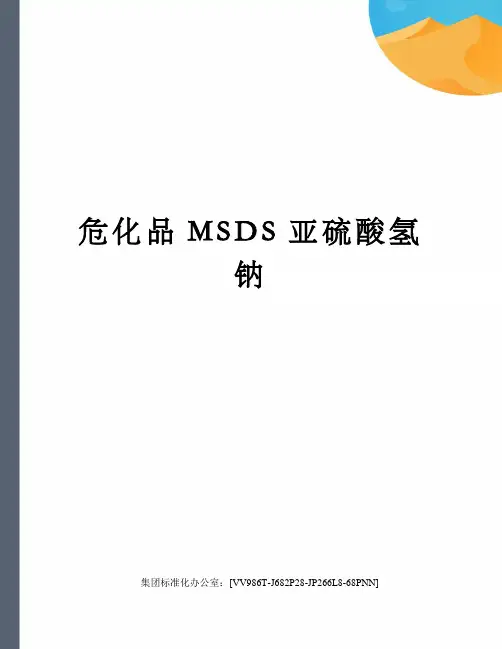
危化品M S D S亚硫酸氢钠集团标准化办公室:[VV986T-J682P28-JP266L8-68PNN]亚硫酸氢钠1. 化学品及企业标识化学品中文名称:亚硫酸氢钠化学品英文名称:sodium bisulfite中文名称2:酸式亚硫酸钠;重亚硫酸钠英文名称2:hydrogen sulfite sodium主要用途:用作漂白剂、媒染剂、蔬菜脱水和保存剂、照相还原剂、医药电镀、造纸等助漂净剂。
2. 危险性概述危险性类别:第类酸性腐蚀品。
侵入途径:吸入、食入。
健康危害:对皮肤、眼、呼吸道有刺激性,可引起过敏反应。
可引起角膜损害,导致失明。
可引起哮喘;大量口服引起恶心、腹痛、腹泻、循环衰竭、中枢神经抑制。
环境危害:对环境有害。
燃爆危险:不燃,无特殊燃爆特性。
3. 成分/组成信息纯品■混合物□主要成分 CAS RN 含量(%)亚硫酸氢钠 7631-90-5;7681-57-44. 急救措施皮肤接触:立即脱去污染的衣着,用大量流动清水冲洗。
如有不适感,就医。
眼睛接触:立即提起眼睑,用大量流动清水或生理盐水彻底冲洗 10~15 分钟。
如有不适感,就医。
吸入:迅速脱离现场至空气新鲜处。
保持呼吸道通畅。
如呼吸困难,给输氧。
呼吸、心跳停止,立即进行心肺复苏术。
就医。
食入:用水漱口,给饮牛奶或蛋清。
就医。
5. 消防措施危险特性:具有强还原性。
接触酸或酸气能产生有毒气体。
受高热分解放出有毒的气体。
具有腐蚀性。
有害燃烧产物:无意义。
灭火方法:本品不燃。
根据着火原因选择适当灭火剂灭火。
灭火注意事项及措施:消防人员必须穿全身耐酸碱消防服、佩戴空气呼吸器灭火。
尽可能将容器从火场移至空旷处。
喷水保持火场容器冷却,直至灭火结束。
6. 泄漏应急措施应急处理:隔离泄漏污染区,限制出入。
建议应急处理人员戴防尘口罩,穿防酸碱服。
穿上适当的防护服前严禁接触破裂的容器和泄漏物。
尽可能切断泄漏源。
用塑料布覆盖泄漏物,减少飞散。
勿使水进入包装容器内。
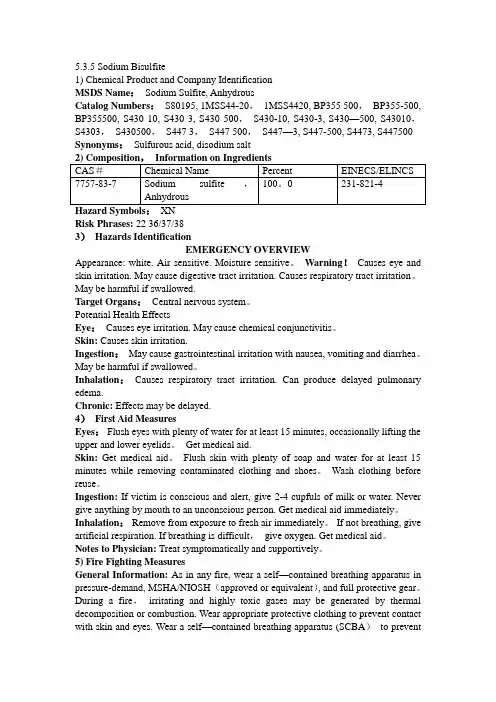
5.3.5 Sodium Bisulfite1) Chemical Product and Company IdentificationMSDS Name:Sodium Sulfite, AnhydrousCatalog Numbers:S80195, 1MSS44-20,1MSS4420, BP355 500,BP355-500, BP355500, S430 10, S430 3, S430 500,S430-10, S430-3, S430—500, S43010,S4303,S430500,S447 3,S447 500,S447—3, S447-500, S4473, S447500 Synonyms:Sulfurous acid, disodium saltRisk Phrases: 22 36/37/383)Hazards IdentificationEMERGENCY OVERVIEWAppearance: white. Air sensitive. Moisture sensitive。
Warning!Causes eye and skin irritation. May cause digestive tract irritation. Causes respiratory tract irritation。
May be harmful if swallowed.Target Organs:Central nervous system。
Potential Health EffectsEye:Causes eye irritation. May cause chemical conjunctivitis。
Skin: Causes skin irritation.Ingestion:May cause gastrointestinal irritation with nausea, vomiting and diarrhea。

第一部分化学品及企业标识主要用途:用作漂白剂、媒染剂、蔬菜脱水和保存剂、照相还原剂、医药电镀、造纸等助漂净剂。
第二部分成分/组成信息化学品中文名称:亚硫酸氢钠化学品英文名:Sodium bisulfite分子式:NaHSO3相对分子质量:104.06有害物成分:亚硫酸氢钠纯品:√混合物:CAS No.7631-90-5浓度:第三部分危险性概述危险性类别:第8.1类酸性腐蚀品侵入途径:吸入、食入、经皮吸收健康危害:对皮肤、眼、呼吸道有刺激性,可引起过敏反应。
可引起角膜损害,导致失明。
可引起哮喘;大量口服引起恶心、腹痛、腹泻、循环衰竭、中枢神经抑制。
第四部分急救措施皮肤接触:立即脱去污染的衣着,用大量流动清水冲洗皮肤。
如有不适感,就医。
眼睛接触:立即提起眼睑,用大量流动清水或生理盐水彻底冲洗至少15分钟。
如有不适感,就医。
吸入:迅速脱离现场至空气新鲜处。
保持呼吸道通畅。
如呼吸困难,给输氧。
如呼吸停止,立即进行人工呼吸。
就医。
食入:饮足量温水,催吐。
就医。
第五部分消防措施危险特性:具有强还原性。
接触酸或酸气能产生有毒气体。
受高热分解放出有毒的气体。
具有腐蚀性。
有害燃烧产物:氧化硫、氧化钠。
灭火方法:本品不燃,跟据周围着火情况,选择适合的灭火器灭火。
灭火注意事项及措施:消防人员必须佩戴空气呼吸器、穿全身耐酸碱消防服,在上风向灭火。
灭火时尽可能将容器从火场移至空旷处,喷水保持容器冷却,直至灭火结束。
第六部分泄漏应急处理应急行动:隔离泄漏污染区,限制出入。
建议应急处理人员戴防尘口罩,穿防酸服。
不要直接接触泄漏物。
小量泄漏:避免扬尘,小心扫起,收集于干燥、洁净、有盖的容器中。
大量泄漏:收集回收或运至废物处理场所处置。
第七部分操作处置与储存操作注意事项:密闭操作,局部排风。
防止粉尘释放到车间空气中。
操作人员必须经过专门培训,严格遵守操作规程。
建议操作人员佩戴自吸过滤式防尘口罩,戴化学安全防护眼镜,穿橡胶耐酸碱服,戴橡胶耐酸碱手套。

亚硫酸氢钠安全技术说明书第一部分:化学品名称化学品中文名称:亚硫酸氢钠化学品俗名:酸式亚硫酸钠化学品英文名称:hydrogen sulfite sodium第二部分:成分/组成信息有害物成分含量亚硫酸氢钠≥40%第三部分:危险性概述侵入途径:吸入、食入、经皮吸收。
健康危害: 对皮肤、眼、呼吸道有刺激性,可引起过敏反应。
可引起角膜损害,导致失明。
可引起哮喘;大量口服引起恶心、腹痛、腹泻、循环衰竭、中枢神经抑制。
环境危害:对环境有危害,对水体可造成污染。
燃爆危险:本品不燃,具腐蚀性,可致人体灼伤。
第四部分:急救措施皮肤接触:立即脱去污染的衣着,用大量流动清水冲洗.就医.眼睛接触:立即提起眼睑,用大量流动清水或生理盐水彻底冲洗至少15分钟.就医。
吸入:迅速脱离现场至空气新鲜处。
保持呼吸道通畅。
如呼吸困难,给输氧。
如呼吸停止,立即进行人工呼吸。
就医.食入:饮足量温水,催吐。
就医。
第五部分:消防措施危险特性:具有强还原性。
接触酸或酸气能产生有毒气体。
受高热分解放出有毒的气体。
具有腐蚀性。
有害燃烧产物:氧化硫、氧化钠。
灭火方法:尽可能将容器从火场移至空旷处。
喷水保持火场容器冷却,直到灭火结束。
第六部分:泄漏应急处理应急处理:隔离泄漏污染区,限制出入。
建议应急处理人员戴防尘口罩,穿防酸服。
不要直接接触泄漏物。
小量泄漏:避免扬尘,小心扫起,收集于干燥、洁净、有盖的容器中。
大量泄漏:收集回收或运至废物处理场所处置。
第七部分:操作处置与储存操作注意事项:密闭操作,局部排风.防止粉尘释放到车间空气中。
操作人员必须经过专门培训,严格遵守操作规程.建议操作人员佩戴自吸过滤式防尘口罩,戴化学安全防护眼镜,穿橡胶耐酸碱服,戴橡胶耐酸碱手套。
避免产生粉尘。
避免与氧化剂、酸类、碱类接触.配备泄漏应急处理设备。
倒空的容器可能残留有害物。
储存注意事项:储存于阴凉、通风的库房。
远离火种、热源。
防止阳光直射。
包装密封。
应与氧化剂、酸类、碱类分开存放,切忌混储。
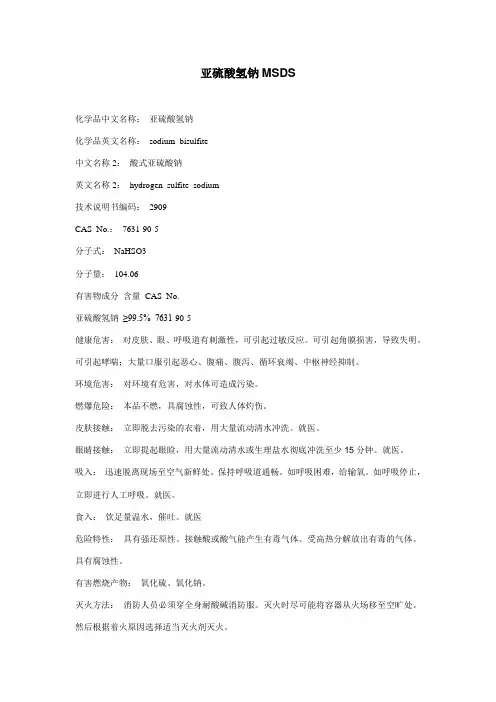
亚硫酸氢钠MSDS化学品中文名称:亚硫酸氢钠化学品英文名称:sodium bisulfite中文名称2:酸式亚硫酸钠英文名称2:hydrogen sulfite sodium技术说明书编码:2909CAS No.:7631-90-5分子式:NaHSO3分子量:104.06有害物成分含量CAS No.亚硫酸氢钠≥99.5% 7631-90-5健康危害:对皮肤、眼、呼吸道有刺激性,可引起过敏反应。
可引起角膜损害,导致失明。
可引起哮喘;大量口服引起恶心、腹痛、腹泻、循环衰竭、中枢神经抑制。
环境危害:对环境有危害,对水体可造成污染。
燃爆危险:本品不燃,具腐蚀性,可致人体灼伤。
皮肤接触:立即脱去污染的衣着,用大量流动清水冲洗。
就医。
眼睛接触:立即提起眼睑,用大量流动清水或生理盐水彻底冲洗至少15分钟。
就医。
吸入:迅速脱离现场至空气新鲜处。
保持呼吸道通畅。
如呼吸困难,给输氧。
如呼吸停止,立即进行人工呼吸。
就医。
食入:饮足量温水,催吐。
就医危险特性:具有强还原性。
接触酸或酸气能产生有毒气体。
受高热分解放出有毒的气体。
具有腐蚀性。
有害燃烧产物:氧化硫、氧化钠。
灭火方法:消防人员必须穿全身耐酸碱消防服。
灭火时尽可能将容器从火场移至空旷处。
然后根据着火原因选择适当灭火剂灭火。
应急处理:隔离泄漏污染区,限制出入。
建议应急处理人员戴防尘口罩,穿防酸服。
不要直接接触泄漏物。
小量泄漏:避免扬尘,小心扫起,收集于干燥、洁净、有盖的容器中。
大量泄漏:收集回收或运至废物处理场所处置。
操作注意事项:密闭操作,局部排风。
防止粉尘释放到车间空气中。
操作人员必须经过专门培训,严格遵守操作规程。
建议操作人员佩戴自吸过滤式防尘口罩,戴化学安全防护眼镜,穿橡胶耐酸碱服,戴橡胶耐酸碱手套。
避免产生粉尘。
避免与氧化剂、酸类、碱类接触。
配备泄漏应急处理设备。
倒空的容器可能残留有害物。
储存注意事项:储存于阴凉、通风的库房。
远离火种、热源。
防止阳光直射。
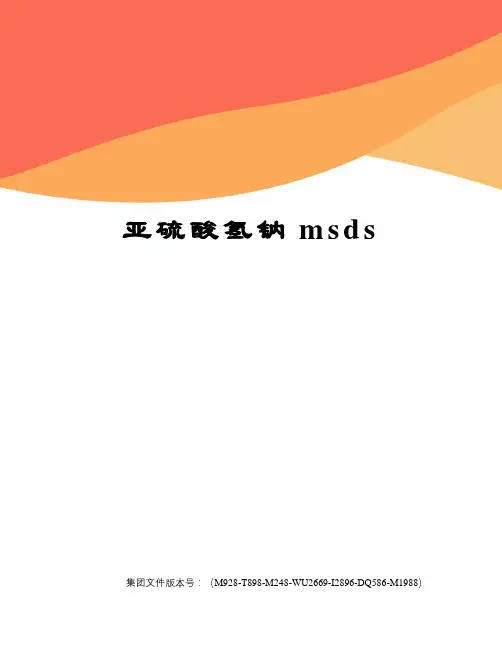
亚硫酸氢钠m s d s集团文件版本号:(M928-T898-M248-WU2669-I2896-DQ586-M1988)亚硫酸氢钠安全说明书第一部分:化学品名称化学品中文名称:亚硫酸氢钠?化学品英文名称: sodium bisulfite?中文名称2:酸式亚硫酸钠英文名称2: hydrogen sulfite sodium技术说明书编码: 2909CAS No.: 7631-90-5?分子式: NaHSO3?分子量: 104.06第二部分:成分/组成信息?回目录有害物成分含量 CAS No.亚硫酸氢钠≥99.5% 7631-90-5第三部分:危险性概述?回目录危险性类别:侵入途径:健康危害:对皮肤、眼、呼吸道有刺激性,可引起过敏反应。
可引起角膜损害,导致失明。
可引起哮喘;大量口服引起恶心、腹痛、腹泻、循环衰竭、中枢神经抑制。
环境危害:对环境有危害,对水体可造成污染。
燃爆危险:本品不燃,具腐蚀性,可致人体灼伤。
第四部分:急救措施?回目录皮肤接触:立即脱去污染的衣着,用大量流动清水冲洗。
就医。
眼睛接触:立即提起眼睑,用大量流动清水或生理盐水彻底冲洗至少15分钟。
就医。
吸入:迅速脱离现场至空气新鲜处。
保持呼吸道通畅。
如呼吸困难,给输氧。
如呼吸停止,立即进行人工呼吸。
就医。
食入:饮足量温水,催吐。
就医。
第五部分:消防措施?回目录危险特性:具有强还原性。
接触酸或酸气能产生有毒气体。
受高热分解放出有毒的气体。
具有腐蚀性。
有害燃烧产物:氧化硫、氧化钠。
灭火方法:消防人员必须穿全身耐酸碱消防服。
灭火时尽可能将容器从火场移至空旷处。
然后根据着火原因选择适当灭火剂灭火。
第六部分:泄漏应急处理?回目录应急处理:隔离泄漏污染区,限制出入。
建议应急处理人员戴防尘口罩,穿防酸服。
不要直接接触泄漏物。
小量泄漏:避免扬尘,小心扫起,收集于干燥、洁净、有盖的容器中。
大量泄漏:收集回收或运至废物处理场所处置。
第七部分:操作处置与储存?回目录操作:密闭操作,局部排风。
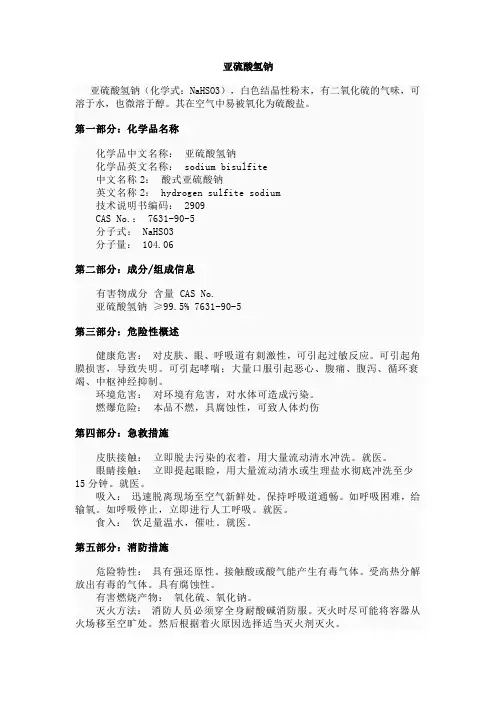
亚硫酸氢钠亚硫酸氢钠(化学式:NaHSO3),白色结晶性粉末,有二氧化硫的气味,可溶于水,也微溶于醇。
其在空气中易被氧化为硫酸盐。
第一部分:化学品名称化学品中文名称:亚硫酸氢钠化学品英文名称: sodium bisulfite中文名称2:酸式亚硫酸钠英文名称2: hydrogen sulfite sodium技术说明书编码: 2909CAS No.: 7631-90-5分子式: NaHSO3分子量: 104.06第二部分:成分/组成信息有害物成分含量 CAS No.亚硫酸氢钠≥99.5% 7631-90-5第三部分:危险性概述健康危害:对皮肤、眼、呼吸道有刺激性,可引起过敏反应。
可引起角膜损害,导致失明。
可引起哮喘;大量口服引起恶心、腹痛、腹泻、循环衰竭、中枢神经抑制。
环境危害:对环境有危害,对水体可造成污染。
燃爆危险:本品不燃,具腐蚀性,可致人体灼伤第四部分:急救措施皮肤接触:立即脱去污染的衣着,用大量流动清水冲洗。
就医。
眼睛接触:立即提起眼睑,用大量流动清水或生理盐水彻底冲洗至少15分钟。
就医。
吸入:迅速脱离现场至空气新鲜处。
保持呼吸道通畅。
如呼吸困难,给输氧。
如呼吸停止,立即进行人工呼吸。
就医。
食入:饮足量温水,催吐。
就医。
第五部分:消防措施危险特性:具有强还原性。
接触酸或酸气能产生有毒气体。
受高热分解放出有毒的气体。
具有腐蚀性。
有害燃烧产物:氧化硫、氧化钠。
灭火方法:消防人员必须穿全身耐酸碱消防服。
灭火时尽可能将容器从火场移至空旷处。
然后根据着火原因选择适当灭火剂灭火。
第六部分:泄漏应急处理应急处理:隔离泄漏污染区,限制出入。
建议应急处理人员戴防尘口罩,穿防酸服。
不要直接接触泄漏物。
小量泄漏:避免扬尘,小心扫起,收集于干燥、洁净、有盖的容器中。
大量泄漏:收集回收或运至废物处理场所处置。
第七部分:操作处置与储存操作注意事项:密闭操作,局部排风。
防止粉尘释放到车间空气中。
操作人员必须经过专门培训,严格遵守操作规程。
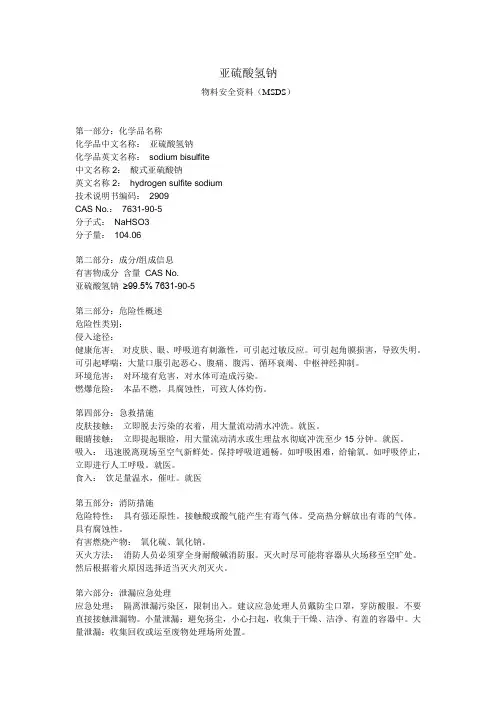
亚硫酸氢钠物料安全资料(MSDS)第一部分:化学品名称化学品中文名称:亚硫酸氢钠化学品英文名称:sodium bisulfite中文名称2:酸式亚硫酸钠英文名称2:hydrogen sulfite sodium技术说明书编码:2909CAS No.:7631-90-5分子式:NaHSO3分子量:104.06第二部分:成分/组成信息有害物成分含量CAS No.亚硫酸氢钠≥99.5% 7631-90-5第三部分:危险性概述危险性类别:侵入途径:健康危害:对皮肤、眼、呼吸道有刺激性,可引起过敏反应。
可引起角膜损害,导致失明。
可引起哮喘;大量口服引起恶心、腹痛、腹泻、循环衰竭、中枢神经抑制。
环境危害:对环境有危害,对水体可造成污染。
燃爆危险:本品不燃,具腐蚀性,可致人体灼伤。
第四部分:急救措施皮肤接触:立即脱去污染的衣着,用大量流动清水冲洗。
就医。
眼睛接触:立即提起眼睑,用大量流动清水或生理盐水彻底冲洗至少15分钟。
就医。
吸入:迅速脱离现场至空气新鲜处。
保持呼吸道通畅。
如呼吸困难,给输氧。
如呼吸停止,立即进行人工呼吸。
就医。
食入:饮足量温水,催吐。
就医第五部分:消防措施危险特性:具有强还原性。
接触酸或酸气能产生有毒气体。
受高热分解放出有毒的气体。
具有腐蚀性。
有害燃烧产物:氧化硫、氧化钠。
灭火方法:消防人员必须穿全身耐酸碱消防服。
灭火时尽可能将容器从火场移至空旷处。
然后根据着火原因选择适当灭火剂灭火。
第六部分:泄漏应急处理应急处理:隔离泄漏污染区,限制出入。
建议应急处理人员戴防尘口罩,穿防酸服。
不要直接接触泄漏物。
小量泄漏:避免扬尘,小心扫起,收集于干燥、洁净、有盖的容器中。
大量泄漏:收集回收或运至废物处理场所处置。
第七部分:操作处置与储存操作注意事项:密闭操作,局部排风。
防止粉尘释放到车间空气中。
操作人员必须经过专门培训,严格遵守操作规程。
建议操作人员佩戴自吸过滤式防尘口罩,戴化学安全防护眼镜,穿橡胶耐酸碱服,戴橡胶耐酸碱手套。
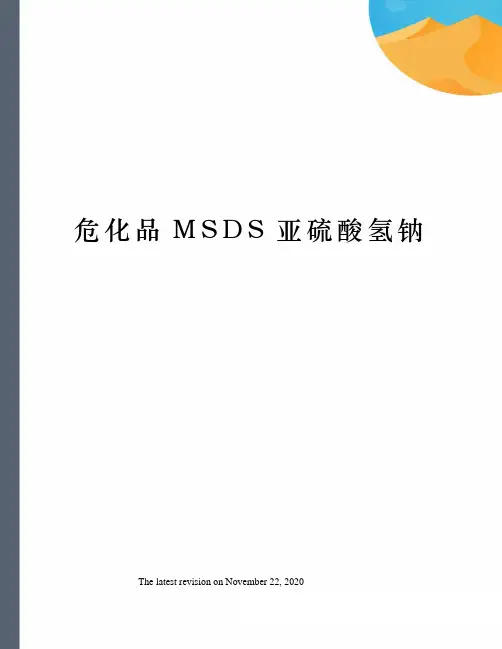
危化品M S D S亚硫酸氢钠 The latest revision on November 22, 2020亚硫酸氢钠1. 化学品及企业标识化学品中文名称:亚硫酸氢钠化学品英文名称:sodium bisulfite中文名称2:酸式亚硫酸钠;重亚硫酸钠英文名称2:hydrogen sulfite sodium主要用途:用作漂白剂、媒染剂、蔬菜脱水和保存剂、照相还原剂、医药电镀、造纸等助漂净剂。
2. 危险性概述危险性类别:第类酸性腐蚀品。
侵入途径:吸入、食入。
健康危害:对皮肤、眼、呼吸道有刺激性,可引起过敏反应。
可引起角膜损害,导致失明。
可引起哮喘;大量口服引起恶心、腹痛、腹泻、循环衰竭、中枢神经抑制。
环境危害:对环境有害。
燃爆危险:不燃,无特殊燃爆特性。
3. 成分/组成信息纯品■混合物□主要成分 CAS RN 含量(%)亚硫酸氢钠 7631-90-5;7681-57-44. 急救措施皮肤接触:立即脱去污染的衣着,用大量流动清水冲洗。
如有不适感,就医。
眼睛接触:立即提起眼睑,用大量流动清水或生理盐水彻底冲洗 10~15 分钟。
如有不适感,就医。
吸入:迅速脱离现场至空气新鲜处。
保持呼吸道通畅。
如呼吸困难,给输氧。
呼吸、心跳停止,立即进行心肺复苏术。
就医。
食入:用水漱口,给饮牛奶或蛋清。
就医。
5. 消防措施危险特性:具有强还原性。
接触酸或酸气能产生有毒气体。
受高热分解放出有毒的气体。
具有腐蚀性。
有害燃烧产物:无意义。
灭火方法:本品不燃。
根据着火原因选择适当灭火剂灭火。
灭火注意事项及措施:消防人员必须穿全身耐酸碱消防服、佩戴空气呼吸器灭火。
尽可能将容器从火场移至空旷处。
喷水保持火场容器冷却,直至灭火结束。
6. 泄漏应急措施应急处理:隔离泄漏污染区,限制出入。
建议应急处理人员戴防尘口罩,穿防酸碱服。
穿上适当的防护服前严禁接触破裂的容器和泄漏物。
尽可能切断泄漏源。
用塑料布覆盖泄漏物,减少飞散。
勿使水进入包装容器内。
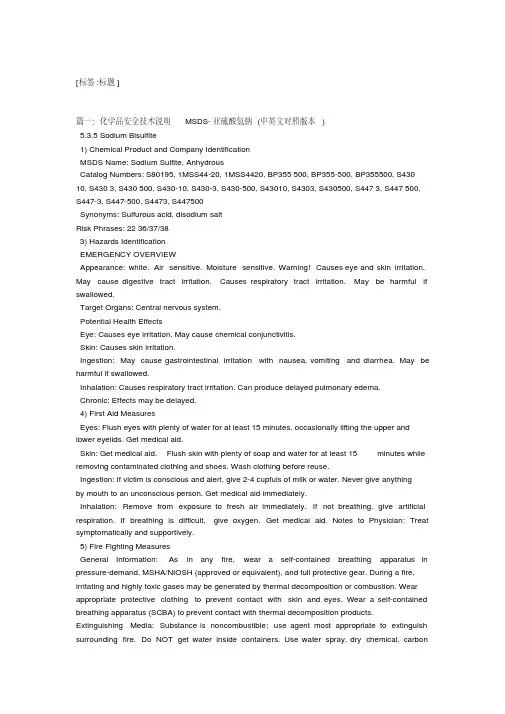
[标签:标题]篇一:化学品安全技术说明MSDS-亚硫酸氢钠(中英文对照版本)5.3.5 Sodium Bisulfite1) Chemical Product and Company IdentificationMSDS Name: Sodium Sulfite, AnhydrousCatalog Numbers: S80195, 1MSS44-20, 1MSS4420, BP355 500, BP355-500, BP355500, S430 10, S430 3, S430 500, S430-10, S430-3, S430-500, S43010, S4303, S430500, S447 3, S447 500,S447-3, S447-500, S4473, S447500Synonyms: Sulfurous acid, disodium saltRisk Phrases: 22 36/37/383) Hazards IdentificationEMERGENCY OVERVIEWAppearance: white. Air sensitive. Moisture sensitive. Warning! Causes eye and skin irritation. May cause digestive tract irritation. Causes respiratory tract irritation. May be harmful if swallowed.Target Organs: Central nervous system.Potential Health EffectsEye: Causes eye irritation. May cause chemical conjunctivitis.Skin: Causes skin irritation.Ingestion: May cause gastrointestinal irritation with nausea, vomiting and diarrhea. May be harmful if swallowed.Inhalation: Causes respiratory tract irritation. Can produce delayed pulmonary edema.Chronic: Effects may be delayed.4) First Aid MeasuresEyes: Flush eyes with plenty of water for at least 15 minutes, occasionally lifting the upper and lower eyelids. Get medical aid.Skin: Get medical aid. Flush skin with plenty of soap and water for at least 15 minutes while removing contaminated clothing and shoes. Wash clothing before reuse.Ingestion: If victim is conscious and alert, give 2-4 cupfuls of milk or water. Never give anythingby mouth to an unconscious person. Get medical aid immediately.Inhalation: Remove from exposure to fresh air immediately. If not breathing, give artificial respiration. If breathing is difficult, give oxygen. Get medical aid. Notes to Physician: Treat symptomatically and supportively.5) Fire Fighting MeasuresGeneral Information: As in any fire, wear a self-contained breathing apparatus in pressure-demand, MSHA/NIOSH (approved or equivalent), and full protective gear. During a fire, irritating and highly toxic gases may be generated by thermal decomposition or combustion. Wear appropriate protective clothing to prevent contact with skin and eyes. Wear a self-contained breathing apparatus (SCBA) to prevent contact with thermal decomposition products. Extinguishing Media: Substance is noncombustible; use agent most appropriate to extinguish surrounding fire. Do NOT get water inside containers. Use water spray, dry chemical, carbon。
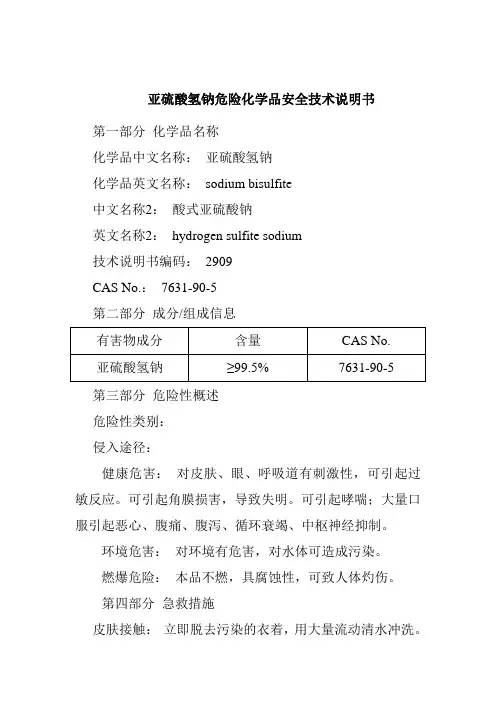
亚硫酸氢钠危险化学品安全技术说明书第一部分化学品名称化学品中文名称:亚硫酸氢钠化学品英文名称:sodium bisulfite中文名称2:酸式亚硫酸钠英文名称2:hydrogen sulfite sodium技术说明书编码:2909CAS No.:7631-90-5第二部分成分/组成信息第三部分危险性概述危险性类别:侵入途径:健康危害:对皮肤、眼、呼吸道有刺激性,可引起过敏反应。
可引起角膜损害,导致失明。
可引起哮喘;大量口服引起恶心、腹痛、腹泻、循环衰竭、中枢神经抑制。
环境危害:对环境有危害,对水体可造成污染。
燃爆危险:本品不燃,具腐蚀性,可致人体灼伤。
第四部分急救措施皮肤接触:立即脱去污染的衣着,用大量流动清水冲洗。
就医。
眼睛接触:立即提起眼睑,用大量流动清水或生理盐水彻底冲洗至少15分钟。
就医。
吸入:迅速脱离现场至空气新鲜处。
保持呼吸道通畅。
如呼吸困难,给输氧。
如呼吸停止,立即进行人工呼吸。
就医。
食入:饮足量温水,催吐。
就医。
第五部分消防措施危险特性:具有强还原性。
接触酸或酸气能产生有毒气体。
受高热分解放出有毒的气体。
具有腐蚀性。
有害燃烧产物:氧化硫、氧化钠。
灭火方法:消防人员必须穿全身耐酸碱消防服。
灭火时尽可能将容器从火场移至空旷处。
然后根据着火原因选择适当灭火剂灭火。
第六部分泄漏应急处理应急处理:隔离泄漏污染区,限制出入。
建议应急处理人员戴防尘口罩,穿防酸服。
不要直接接触泄漏物。
小量泄漏:避免扬尘,小心扫起,收集于干燥、洁净、有盖的容器中。
大量泄漏:收集回收或运至废物处理场所处置。
第七部分操作处置与储存操作注意事项:密闭操作,局部排风。
防止粉尘释放到车间空气中。
操作人员必须经过专门培训,严格遵守操作规程。
建议操作人员佩戴自吸过滤式防尘口罩,戴化学安全防护眼镜,穿橡胶耐酸碱服,戴橡胶耐酸碱手套。
避免产生粉尘。
避免与氧化剂、酸类、碱类接触。
配备泄漏应急处理设备。
倒空的容器可能残留有害物。
储存注意事项:储存于阴凉、通风的库房。
亚硫酸氢钠化学品安全技术说明书(MSDS)第一部分:化学品名称化学品中文名称:亚硫酸氢钠化学品英文名称:sodium bisulfite中文别名:英文别名:技术说明书编码:分子式:NaHSO3分子量:104.06第二部分:成分/组成信息主要成分:含量:工业级≥99.5%。
CAS No.:7631-90-5第三部分:危险性概述危险性类别:侵入途径:健康危害:对皮肤、眼、呼吸道有刺激性,可引起过敏反应。
可引起角膜损害,导致失明。
可引起哮喘;大量口服引起恶心、腹痛、腹泻、循环衰竭、中枢神经抑制。
环境危害:燃爆危险:第四部分:急救措施皮肤接触:立即脱去污染的衣着,用大量流动清水冲洗。
就医。
眼睛接触:立即提起眼睑,用大量流动清水或生理盐水彻底冲洗至少15分钟。
就医。
吸入:迅速脱离现场至空气新鲜处。
保持呼吸道通畅。
如呼吸困难,给输氧。
如呼吸停止,立即进行人工呼吸。
就医。
食入:饮足量温水,催吐。
就医。
第五部分:消防措施危险特性:具有强还原性。
接触酸或酸气能产生有毒气体。
受高热分解放出有毒的气体。
具有腐蚀性。
有害燃烧产物:灭火方法:消防人员必须穿全身耐酸碱消防服。
灭火时尽可能将容器从火场移至空旷处。
然后根据着火原因选择适当灭火剂灭火。
灭火注意事项及措施:第六部分:泄漏应急处理应急处理:隔离泄漏污染区,限制出入。
建议应急处理人员戴防尘口罩,穿防酸服。
不要直接接触泄漏物。
小量泄漏:避免扬尘,小心扫起,收集于干燥、洁净、有盖的容器中。
大量泄漏:收集回收或运至废物处理场所处置。
第七部分:操作处置与储存操作注意事项:储存注意事项:储存于阴凉、通风的库房。
远离火种、热源。
防止阳光直射。
包装密封。
应与氧化剂、酸类、碱类分开存放,切忌混储。
不宜久存,以免变质。
储区应备有合适的材料收容泄漏物。
第八部分:接触控制/个体防护最高容许浓度:中国MAC:未制定标准; 前苏联MAC:未制定标准监测方法:工程控制:密闭操作,局部排风。
呼吸系统防护:空气中粉尘浓度超标时,必须佩戴自吸过滤式防尘口罩。
亚硫酸氢钠MSDS化学品名称为亚硫酸氢钠,适用于太阳能光伏行业和半导体等电子行业。
本品具有对皮肤、眼睛和呼吸道的刺激性,可能引起过敏反应、角膜损伤、哮喘、恶心、腹泻、循环衰竭和中枢神经抑制。
同时,它还会对环境造成危害,对水体造成污染。
此外,本品不燃,但具有腐蚀性,可能致人体灼伤。
亚硫酸氢钠的成分信息包括中英文名称、同义名称、化学文摘登记号以及危害物质成分。
在急救措施方面,如果吸入本品,应立即脱离现场至空气新鲜处,并保持呼吸道通畅。
如果呼吸困难,应给输氧。
如果呼吸停止,应立即进行人工呼吸,并就医。
如果皮肤接触本品,应立即脱去污染的衣着,用大量流动清水冲洗,并就医。
如果眼睛接触本品,应立即提起眼睑,用大量流动清水或生理盐水彻底冲洗至少15分钟,并就医。
在消防措施方面,亚硫酸氢钠具有强还原性,接触酸或酸气能产生有毒气体,受高热分解会放出有毒的气体,同时还具有腐蚀性。
灭火时应穿全身耐酸碱消防服,将从火场移至空旷处,然后选择适当灭火剂灭火。
在泄漏应急处理方面,消防人员必须穿全身耐酸碱消防服。
应隔离泄漏污染区,限制出入,并建议应急处理人员戴防尘口罩,穿防酸服。
小量泄漏应避免扬尘,小心扫起,收集于干燥、洁净、有盖的中。
大量泄漏应收集回收或运至废物处理场所处置。
在操作处置与储存方面,应密闭操作,局部排风,防止粉尘释放到车间空气中。
操作人员必须经过专门培训,严格遵守操作规程,并佩戴自吸过滤式防尘口罩、化学安全防护眼镜、橡胶耐酸碱服和橡胶耐酸碱手套。
配备泄漏应急处理设备。
倒空的可能残留有害物,应存于阴凉、通风的库房,远离火源和热源,防止阳光直射,包装密封。
应与氧化剂、酸类、碱类分开存放,不宜久存,储区应备有合适的材料收容泄漏物。
在接触控制和个体防护方面,最高允许浓度应符合相关标准,监测方法应选择合适的检测仪器。
应采取工程控制措施,如局部排风和密闭操作。
呼吸系统防护、眼睛防护等个体防护措施也应采取。
Body nXXXOther n9.Physical and Chemical PropertiesPhysical State: PowderXXX。
亚硫酸氢钠安全技术说明书第一部分:化学品名称化学品中文名称:亚硫酸氢钠化学品俗名:酸式亚硫酸钠化学品英文名称:hydrogen sulfite sodium第二部分:成分/组成信息有害物成分含量亚硫酸氢钠≥40%第三部分:危险性概述侵入途径:吸入、食入、经皮吸收。
健康危害:对皮肤、眼、呼吸道有刺激性,可引起过敏反应。
可引起角膜损害,导致失明。
可引起哮喘;大量口服引起恶心、腹痛、腹泻、循环衰竭、中枢神经抑制。
环境危害:对环境有危害,对水体可造成污染。
燃爆危险:本品不燃,具腐蚀性,可致人体灼伤。
第四部分:急救措施皮肤接触:立即脱去污染的衣着,用大量流动清水冲洗。
就医。
眼睛接触:立即提起眼睑,用大量流动清水或生理盐水彻底冲洗至少15分钟。
就医。
吸入:迅速脱离现场至空气新鲜处。
保持呼吸道通畅。
如呼吸困难,给输氧。
如呼吸停止,立即进行人工呼吸。
就医。
食入:饮足量温水,催吐。
就医。
第五部分:消防措施危险特性:具有强还原性。
接触酸或酸气能产生有毒气体。
受高热分解放出有毒的气体。
具有腐蚀性。
有害燃烧产物:氧化硫、氧化钠。
灭火方法:尽可能将容器从火场移至空旷处。
喷水保持火场容器冷却,直到灭火结束。
第六部分:泄漏应急处理应急处理:隔离泄漏污染区,限制出入。
建议应急处理人员戴防尘口罩,穿防酸服。
不要直接接触泄漏物。
小量泄漏:避免扬尘,小心扫起,收集于干燥、洁净、有盖的容器中。
大量泄漏:收集回收或运至废物处理场所处置。
第七部分:操作处置与储存操作注意事项:密闭操作,局部排风。
防止粉尘释放到车间空气中。
操作人员必须经过专门培训,严格遵守操作规程。
建议操作人员佩戴自吸过滤式防尘口罩,戴化学安全防护眼镜,穿橡胶耐酸碱服,戴橡胶耐酸碱手套。
避免产生粉尘。
避免与氧化剂、酸类、碱类接触。
配备泄漏应急处理设备。
倒空的容器可能残留有害物。
储存注意事项:储存于阴凉、通风的库房。
远离火种、热源。
防止阳光直射。
包装密封。
应与氧化剂、酸类、碱类分开存放,切忌混储。
集小片区2020-2021学年(下)三年级数学期中测试卷(本卷满分100分书写分:2分完卷时间: 60 分钟)一、我会填(18分)1.在除法中,0除以任何不是0的数都得()2.三位数除以一位数(0除外),商可能是()位数,也可能是()位数。
3. 28÷7,要使商是三位数, 中最小填();要使商是两位数, 中最大填()。
4.最小的三位数除以最大的一位数,商是(),余数是()。
5.40的2倍是(),320是()的4倍。
6.估算29×42时,可以把29看作(),把42看作(),积大约是()。
7.乐乐中午放学回家,先向北走200米到科技街,再向东北走400米到家,下午上学时,乐乐应先向( )走()米到科技街,再向()走()米到学校。
8.3 6 1 使商的中间有0, 里可能填();要使商的中间有0且没有余数, 里应填()。
二、我会选(18分)1.下面算式中,商的末尾是0的算式是()A.530÷5B.480÷4C.870÷52.地图上,福建省位于我国的()方向A.东B.南C.东南3.()÷9=48...... ,当余数最大时,被除数是()A.441B.440C.4424.积大约是4200的算式是()A.58×71B.58×62C.69×695.在如右图所示的竖式计算中,84中的8表示()A.8个一B. 8个十C. 8个百D.8个千6.花店运来127朵百合,下面第()种扎法剩下的枝数最多。
A.每4枝扎一束B.每5枝扎了一束C.每6枝扎了一束三、我会算(28分)1.直接写得数。
(8分)2000÷5= 38+53= 100-29= 60×700=29×3= 4800÷8= 362÷9≈401÷4≈2.用竖式计算。
带*的要验算(14分)78×60= 289×7= 38×47=605÷4= *724÷7= *552÷8=3.脱式计算。
亚硫酸氢钠1. 化学品及企业标识化学品中文名称:亚硫酸氢钠化学品英文名称:sodium bisulfite中文名称2:酸式亚硫酸钠;重亚硫酸钠英文名称2:hydrogen sulfite sodium主要用途:用作漂白剂、媒染剂、蔬菜脱水和保存剂、照相还原剂、医药电镀、造纸等助漂净剂。
2. 危险性概述2.1 危险性类别:第8.1 类酸性腐蚀品。
2.2侵入途径:吸入、食入。
2.3健康危害:对皮肤、眼、呼吸道有刺激性,可引起过敏反应。
可引起角膜损害,导致失明。
可引起哮喘;大量口服引起恶心、腹痛、腹泻、循环衰竭、中枢神经抑制。
2.4环境危害:对环境有害。
2.5燃爆危险:不燃,无特殊燃爆特性。
3. 成分/组成信息纯品■混合物□主要成分CAS RN 含量(%)亚硫酸氢钠7631-90-5;7681-57-4 58.54. 急救措施4.1 皮肤接触:立即脱去污染的衣着,用大量流动清水冲洗。
如有不适感,就医。
4.2眼睛接触:立即提起眼睑,用大量流动清水或生理盐水彻底冲洗10~15 分钟。
如有不适感,就医。
4.3吸入:迅速脱离现场至空气新鲜处。
保持呼吸道通畅。
如呼吸困难,给输氧。
呼吸、心跳停止,立即进行心肺复苏术。
就医。
4.4食入:用水漱口,给饮牛奶或蛋清。
就医。
5. 消防措施5.1 危险特性:具有强还原性。
接触酸或酸气能产生有毒气体。
受高热分解放出有毒的气体。
具有腐蚀性。
5.2有害燃烧产物:无意义。
5.3灭火方法:本品不燃。
根据着火原因选择适当灭火剂灭火。
5.4灭火注意事项及措施:消防人员必须穿全身耐酸碱消防服、佩戴空气呼吸器灭火。
尽可能将容器从火场移至空旷处。
喷水保持火场容器冷却,直至灭火结束。
6. 泄漏应急措施应急处理:隔离泄漏污染区,限制出入。
建议应急处理人员戴防尘口罩,穿防酸碱服。
穿上适当的防护服前严禁接触破裂的容器和泄漏物。
尽可能切断泄漏源。
用塑料布覆盖泄漏物,减少飞散。
勿使水进入包装容器内。
用洁净的铲子收集泄漏物,置于干净、干燥、盖子较松的容器中,将容器移离泄漏区。
亚硫酸氢钠安全说明书第一部分:化学品名称化学品中文名称:亚硫酸氢钠化学品英文名称:sodium bisulfite中文名称2:酸式亚硫酸钠英文名称2:hydrogen sulfite sodium技术说明书编码:2909CAS No.:7631-90-5分子式:NaHSO3分子量:104.06第二部分:成分/组成信息回目录有害物成分含量CAS No.亚硫酸氢钠≥99.5% 7631-90-5第三部分:危险性概述回目录危险性类别:侵入途径:健康危害:对皮肤、眼、呼吸道有刺激性,可引起过敏反应。
可引起角膜损害,导致失明。
可引起哮喘;大量口服引起恶心、腹痛、腹泻、循环衰竭、中枢神经抑制。
环境危害:对环境有危害,对水体可造成污染。
燃爆危险:本品不燃,具腐蚀性,可致人体灼伤。
第四部分:急救措施回目录皮肤接触:立即脱去污染的衣着,用大量流动清水冲洗。
就医。
眼睛接触:立即提起眼睑,用大量流动清水或生理盐水彻底冲洗至少15分钟。
就医。
吸入:迅速脱离现场至空气新鲜处。
保持呼吸道通畅。
如呼吸困难,给输氧。
如呼吸停止,立即进行人工呼吸。
就医。
食入:饮足量温水,催吐。
就医。
第五部分:消防措施回目录危险特性:具有强还原性。
接触酸或酸气能产生有毒气体。
受高热分解放出有毒的气体。
具有腐蚀性。
有害燃烧产物:氧化硫、氧化钠。
灭火方法:消防人员必须穿全身耐酸碱消防服。
灭火时尽可能将容器从火场移至空旷处。
然后根据着火原因选择适当灭火剂灭火。
第六部分:泄漏应急处理回目录应急处理:隔离泄漏污染区,限制出入。
建议应急处理人员戴防尘口罩,穿防酸服。
不要直接接触泄漏物。
小量泄漏:避免扬尘,小心扫起,收集于干燥、洁净、有盖的容器中。
大量泄漏:收集回收或运至废物处理场所处置。
第七部分:操作处置与储存回目录操作注意事项:密闭操作,局部排风。
防止粉尘释放到车间空气中。
操作人员必须经过专门培训,严格遵守操作规程。
建议操作人员佩戴自吸过滤式防尘口罩,戴化学安全防护眼镜,穿橡胶耐酸碱服,戴橡胶耐酸碱手套。
5.3.5 Sodium Bisulfite1) Chemical Product and Company IdentificationMSDS Name: Sodium Sulfite, AnhydrousCatalog Numbers: S80195, 1MSS44-20, 1MSS4420, BP355 500, BP355-500, BP355500, S430 10, S430 3, S430 500, S430-10, S430-3, S430-500, S43010, S4303, S430500, S447 3, S447 500, S447-3, S447-500, S4473, S447500 Synonyms: Sulfurous acid, disodium saltRisk Phrases: 22 36/37/383) Hazards IdentificationEMERGENCY OVERVIEWAppearance: white. Air sensitive. Moisture sensitive. Warning!Causes eye and skin irritation. May cause digestive tract irritation. Causes respiratory tract irritation. May be harmful if swallowed.Target Organs: Central nervous system.Potential Health EffectsEye: Causes eye irritation. May cause chemical conjunctivitis.Skin: Causes skin irritation.Ingestion: May cause gastrointestinal irritation with nausea, vomiting and diarrhea. May be harmful if swallowed.Inhalation: Causes respiratory tract irritation. Can produce delayed pulmonary edema.Chronic: Effects may be delayed.4) First Aid MeasuresEyes: Flush eyes with plenty of water for at least 15 minutes, occasionally lifting the upper and lower eyelids. Get medical aid.Skin: Get medical aid. Flush skin with plenty of soap and water for at least 15 minutes while removing contaminated clothing and shoes. Wash clothing before reuse.Ingestion: If victim is conscious and alert, give 2-4 cupfuls of milk or water. Never give anything by mouth to an unconscious person. Get medical aid immediately.Inhalation: Remove from exposure to fresh air immediately. If not breathing, give artificial respiration. If breathing is difficult, give oxygen. Get medical aid.Notes to Physician: Treat symptomatically and supportively.5) Fire Fighting MeasuresGeneral Information: As in any fire, wear a self-contained breathing apparatus in pressure-demand, MSHA/NIOSH (approved or equivalent), and full protective gear. During a fire, irritating and highly toxic gasesmay be generated by thermal decomposition or combustion. Wear appropriate protective clothing to prevent contact with skin and eyes. Wear a self-contained breathing apparatus (SCBA) to prevent contact with thermal decomposition products.Extinguishing Media:Substance is noncombustible; use agent most appropriate to extinguish surrounding fire. Do NOT get water inside containers. Use water spray, dry chemical, carbon dioxide, or appropriate foam.6) Accidental Release MeasuresGeneral Information: Use proper personal protective equipment as indicated in Section 8.Spills/Leaks: Vacuum or sweep up material and place into a suitable disposal container. Clean up spills immediately, observing precautions in the Protective Equipment section. Avoid generating dusty conditions. Provide ventilation. Place under an inert atmosphere. Do not get water inside containers.7) Handling and StorageHandling: Wash thoroughly after handling. Use with adequate ventilation. Minimize dust generation and accumulation. Avoid contact with eyes, skin, and clothing. Keep container tightly closed. Avoid ingestion and inhalation. Handle under an inert atmosphere. Store protected from air. Do not allow contact with water. Wash clothing before reuse. Keep from contact with moist air and steam.Storage: Store in a tightly closed container. Keep from contact with oxidizing materials. Store in a cool, dry, well-ventilated area away from incompatible substances. Keep away from strong acids. Do not expose to air. Store protected from moisture. Store under an inert atmosphere.8) Exposure Controls, Personal ProtectionEngineering Controls: Facilities storing or utilizing this material should be equipped with an eyewash facility and a safety shower. Use adequate ventilation to keep airborne concentrations low.listed for this chemical.Personal Protective EquipmentEyes: Wear appropriate protective eyeglasses or chemical safety goggles as described by OSHA's eye and face protection regulations in 29 CFR 1910.133 or European Standard EN166.Skin: Wear appropriate protective gloves to prevent skin exposure. Clothing: Wear appropriate protective clothing to prevent skin exposure. Respirators: A respiratory protection program that meets OSHA's 29 CFR§1910.134 and ANSI Z88.2 requirements or European Standard EN 149 must be followed whenever workplace conditions warrant a respirator's use. Follow the OSHA respirator regulations found in 29CFR 1910.134 or European Standard EN 149. Always use a NIOSH or European Standard EN 149 approved respirator when necessary.9) Physical and Chemical PropertiesPhysical State: SolidAppearance: whiteOdor: odorlesspH: Not available.Vapor Pressure: Not available.Vapor Density: Not available.Evaporation Rate: Not available.Viscosity: Not available.Boiling Point: Not available.Freezing/Melting Point: Not available.Autoignition Temperature: Not available.Flash Point: Not available.Decomposition Temperature: > 500 deg CNFPA Rating: (estimated) Health: 2; Flammability: 0; Reactivity: 0 Explosion Limits, Lower: Not available.Upper: Not available.Solubility: 23 g/100 mL water (20° C)Specific Gravity/Density: 2.6330g/cm3Molecular Formula: Na2O3SMolecular Weight: 126.0410) Stability and ReactivityChemical Stability: Stable at room temperature in closed containers under normal storage and handling conditions.Conditions to Avoid: Incompatible materials, dust generation, moisture, exposure to air, excess heat.Incompatibilities with Other Materials: Strong oxidizing agents, acids, organics, moisture, air, combustible materials.Hazardous Decomposition Products: Oxides of sulfur.Hazardous Polymerization: Has not been reported.11) Toxicological InformationRTECS#:CAS# 7757-83-7: WE2150000LD50/LC50:CAS# 7757-83-7:Oral, mouse: LD50 = 820 mg/kg;Carcinogenicity:CAS# 7757-83-7: Not listed by ACGIH, IARC, NIOSH, NTP, or OSHA. Epidemiology: No information available.Teratogenicity: No information available.Reproductive Effects: No information available.Neurotoxicity: No information available.Mutagenicity: No information available.Other Studies: No data available.12) Ecological InformationEcotoxicity: No data available. No information available. Environmental: No information found.Physical: No information found.Other: No information available.13) Disposal ConsiderationsChemical waste generators must determine whether a discarded chemical is classified as a hazardous waste. US EPA guidelines for the classification determination are listed in 40 CFR Parts 261.3. Additionally, waste generators must consult state and local hazardous waste regulations to ensure complete and accurate classification.RCRA P-Series: None listed.RCRA U-Series: None listed.US FEDERALTSCACAS# 7757-83-7 is listed on the TSCA inventory.Health & Safety Reporting ListNone of the chemicals are on the Health & Safety Reporting List. Chemical Test RulesNone of the chemicals in this product are under a Chemical Test Rule. Section 12bNone of the chemicals are listed under TSCA Section 12b.TSCA Significant New Use RuleNone of the chemicals in this material have a SNUR under TSCA.SARASection 302 (RQ)None of the chemicals in this material have an RQ.Section 302 (TPQ)None of the chemicals in this product have a TPQ.SARA CodesCAS # 7757-83-7: acute.Section 313No chemicals are reportable under Section 313.Clean Air Act:This material does not contain any hazardous air pollutants. This material does not contain any Class 1 Ozone depletors. This material does not contain any Class 2 Ozone depletors.Clean Water Act:None of the chemicals in this product are listed as Hazardous Substances under the CWA. None of the chemicals in this product are listed as Priority Pollutants under the CWA. None of the chemicals in this product are listed as Toxic Pollutants under the CWA.OSHA:None of the chemicals in this product are considered highly hazardous by OSHA.STATECAS# 7757-83-7 is not present on state lists from CA, PA, MN, MA, FL, or NJ.California No Significant Risk Level: None of the chemicals in this product are listed. European/International RegulationsEuropean Labeling in Accordance with EC DirectivesHazard Symbols:XNRisk Phrases:R 22 Harmful if swallowed.R 36/37/38 Irritating to eyes, respiratory systemand skin.Safety Phrases:S 24/25 Avoid contact with skin and eyes.WGK (Water Danger/Protection)CAS# 7757-83-7: 1CanadaCAS# 7757-83-7 is listed on Canada's DSL List. CAS# 7757-83-7 is listed on Canada's DSL List.This product has a WHMIS classification of D2B.CAS# 7757-83-7 is not listed on Canada's Ingredient Disclosure List. Exposure Limits16) Additional InformationMSDS Creation Date: 7/15/1999Revision #1 Date: 8/02/2000The information above is believed to be accurate and represents the best information currently available to us. However, we make no warranty ofmerchantability or any other warranty, express or implied, with respect to such information, and we assume no liability resulting from its use. Users should make their own investigations to determine the suitability of the information for their particular purposes. In no event shall Fisher be liable for any claims, losses, or damages of any third party or for lost profits or any special, indirect, incidental, consequential or exemplary damages, howsoever arising, even if Fisher has been advised of the possibility of such damages.5.3.5亚硫酸氢钠1)化学品名称化学品中文名称:亚硫酸氢钠化学品英文名称:sodium bisulfite中文名称2:酸式亚硫酸钠英文名称2:hydrogen sulfite sodium分子式:NaHSO3分子量:104.06健康危害:对皮肤、眼、呼吸道有刺激性,可引起过敏反应。